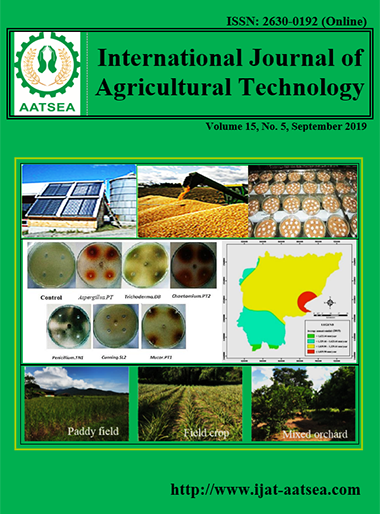Pioneering commercialization of certified cassava seed production: Impacts on sustainable cassava production, income and wealth creation in Uganda
Main Article Content
Abstract
Cassava is one of the most important food crops and sources of income for Uganda’s smallholder farmers. However, yields are low due to diseases like cassava brown streak and cassava mosaic, poor quality of planting materials used and declining soil fertility, among other factors. To address the challenge of poor quality planting materials, a program aimed at establishing a functional cassava seed system to monitor production and marketing of certified cassava seed was implemented. This study evaluated the impacts of this intervention on certified cassava seed multipliers and sellers (CSEs) and smallholder farmers (SHFs) in Uganda. A survey was conducted to assess the benefits of inspection and certification to CSEs, CSEs willingness to pay for inspection and certification services, farmers’ access status to clean planting materials of improved cassava varieties, and farmers’ yields and income. Majority of CSEs (74%) reported planting, production and marketing of high-quality planting materials as main benefit of inspection and certification, followed by improved knowledge on cassava crop management (67%), and better prices for certified planting materials (56%). A bigger proportion of CSEs (63%) reported the willingness to pay for inspection and certification costs, with majority (56%) willing to pay USD 11-20 per inspection. Forty percent of SHFs reported increased access to improved planting materials which was attributed to community-based cassava seed multiplication fields established by CSEs in the areas. Additionally, 80 and 47% of CSEs and SHFs, respectively, reported increased yields from planting clean planting materials, and this was associated with improved household income. The study shows positive impacts of the intervention towards creating a functional cassava seed system. However, farmers reported high costs for clean planting materials from CSEs. Therefore, to make the seed system efficient and sustainable, deliberate efforts should be made to ensure farmers affordably access planting materials for sustainable cassava production.
Article Details

This work is licensed under a Creative Commons Attribution-NonCommercial-NoDerivatives 4.0 International License.
References
Abdoulaye, T., Abass, A., Maziya, D. B., Tarawali, G., Okechukwu, R., Rusike, J., Alene, A., Manyong, V. and Ayedun, B. (2013). Awareness and adoption of improved cassava varieties and processing technologies in Nigeria. Journal of Development and Agricultural Economics, 6:67-75.
Adebayo, B. A., Elifatio, T., Ivor, M., Richardson, O., Roger, R., Gbassey, T. and Edward, K. (2014). Growing Cassava: A training manual from production to postharvest. International Institute of Tropical Agriculture (IITA), Ibadan, Nigeria, pp.1-36.
Acheampong, P. P. and Owusu, V. (2015). Impact of improved cassava varieties’ adoption on farmers’ incomes in Rural Ghana. Paper presented at the 29th Triennial Conference of the International Association of Agricultural Economists (IAAE), Milan, Italy, pp. 8-14.
Afolami, C. A., Abiodun, E. O. and Vaughan, I. I. (2015). Welfare impact of adoption of improved cassava varieties by rural households in South Western Nigeria. Agricultural and Food Economics, 3:1-7.
Amao, J. O. and Awoyemi, T. T. (2008). Adoption of improved cassava varieties and its welfare effect on producing households in osogbo adp zone of Osun State. Department of Agricultural Economics and Extension, Ladoke Akintola University of Technology. PMB 4000, Ogbomoso. Oyo State, Nigeria, pp.1-11.
Anna, B., Roslyn, G., Julie, C., Anabela, Z. and Timothy, C. (2010). Cassava: The drought, war and famine crop in a changing world. Sustainability, 2:3572-3607.
Centro Internacional de Agricultura Tropical (CIAT, 2015). Sustainable cassava production in Asia for multiple uses and for multiple markets. In: Proceedings of the Ninth Regional Cassava Workshop, held in Nanning, Guangxi, China P.R., pp.1-347.
FAO (2013). Save and grow cassava: A guide to sustainable production intensification. ISBN 978-92-5-107641-5: 1-24.
Fermont, A. M., Tittonell, P. A., Baguma, Y., Ntawuruhunga, P. and Giller, K. E. (2010). Towards understanding factors that govern fertilizer response in cassava: Lessons from East Africa. Nutrient Cycling in Agroecosystems, 86:133-151, DOI 10.1007/s10705-009-9278-3.
Gildemacher, P., Kleijn, W., Ndung’u, D., Kapran, I., Yogo, J., Laizer, R., Nimpagritse, D., Kadeoua, A., Karanja, D., Simbashizubwoba, C., Ntamavukiro, A., Niangado, O., Oyee, P., Chebet, A. N., Marandu, D., Minneboo, E., Gitu, G., Walsh, S. and Kugbei, S. (2017). Effective seed quality assurance. Integrated Seed Sector Development (ISSD) Africa: Synthesis paper, Pp.1-20.
Ijala, A. R., Alacho, F. O., Ogwang, S. B., Awio, T., Aseere, G. and Otim-Nape, G. W. (2017). Evaluating low cost and sustainable high quality cassava drying technologies among small and medium processors in Uganda. Journal of Food Science and Engineering, 7:453-457, doi: 10.17265/2159 5828/2017.09.005.
Khonje, M., Mkandawire, P., Manda, J. and Arega, DA. (2015). Analysis of adoption and impacts of improved cassava varieties in Zambia. Paper presented at the 29th Triennial Conference of the International Association of Agricultural Economists (IAAE), Milan, Italy, pp.8-14.
Kyamanywa, S., Kashaija, I., Getu, E., Amata, R., Senkesha, N. and Kullaya, A. (2011). Enhancing food security through improved seed systems of appropriate varieties of cassava, potato and sweet potato resilient to climate change in Eastern Africa. International Livestock Research Institute, Nairobi, Kenya, pp.1-30.
Leihner, D. E. (2002). Agronomy and Cropping Systems. In Cassava: Biology, Production and Utilization; Hillocks, R. J., Thresh, J. M., Bellotti and A. C. (Eds.); CABI Publishing, UK, pp. 91-113.
Louise, S., Sara, B. and Ian, B. (2013). Integrating Seed Systems. AgPartnerXChange, Planning for Scale Brief, 3:1-32.
National Agricultural Research Organization (NARO) (2014). Annual Report, Ministry of Agriculture, Animal Industry and Fisheries, Entebbe, Uganda.
National Crops Resources Research Institute (NaCRRI) (2014). Cassava: Uganda’s food security crop. Bulletin by NaCRRI, Namulonge, Uganda, pp.1-10.
Ralph, L. R. and Magado, R. (2011). Revival of cassava production in Nakasongola District, Uganda. International Journal of Agricultural Sustainability, 9:76-81. DOI: 10.3763/ijas.2010.0547.
Reinhardt, H. H. (2002). Agronomic practices for sustainable cassava production in Asia. CIAT, Cassava office for Asia; Department of Agriculture, Chatuchak, Bangkok, Thailand, pp.1-27.
Uganda bureau of statistics, UBOS and MAAIF (2010). Uganda Census of Agriculture: Crop Area and Production Report, 4:1-178.
VLSA-Uganda (2013). Best agronomic practices for cassava production and post-harvest handling: Handbook for Livelihood Promoters and Extension Agents, pp.1-28.


